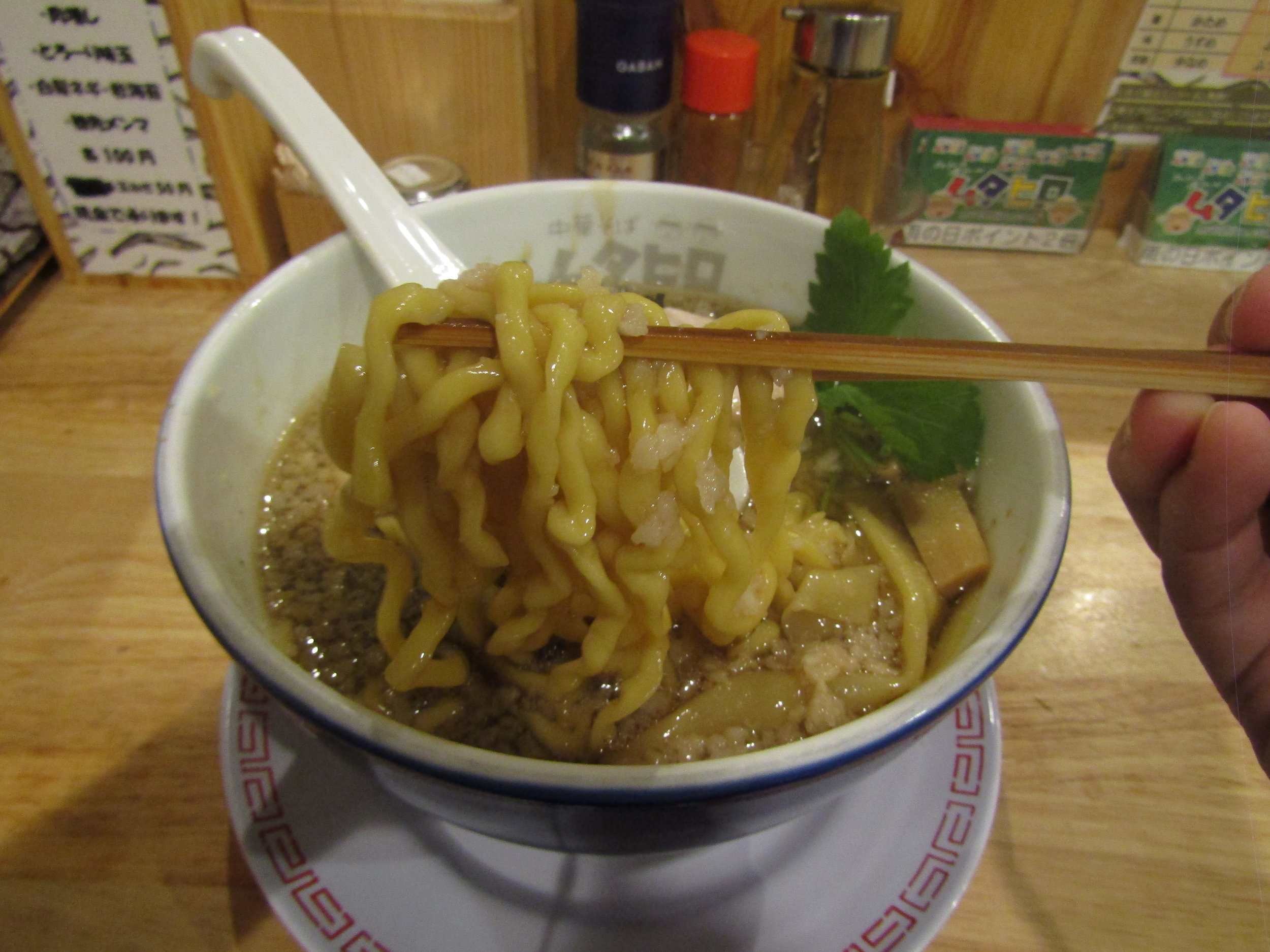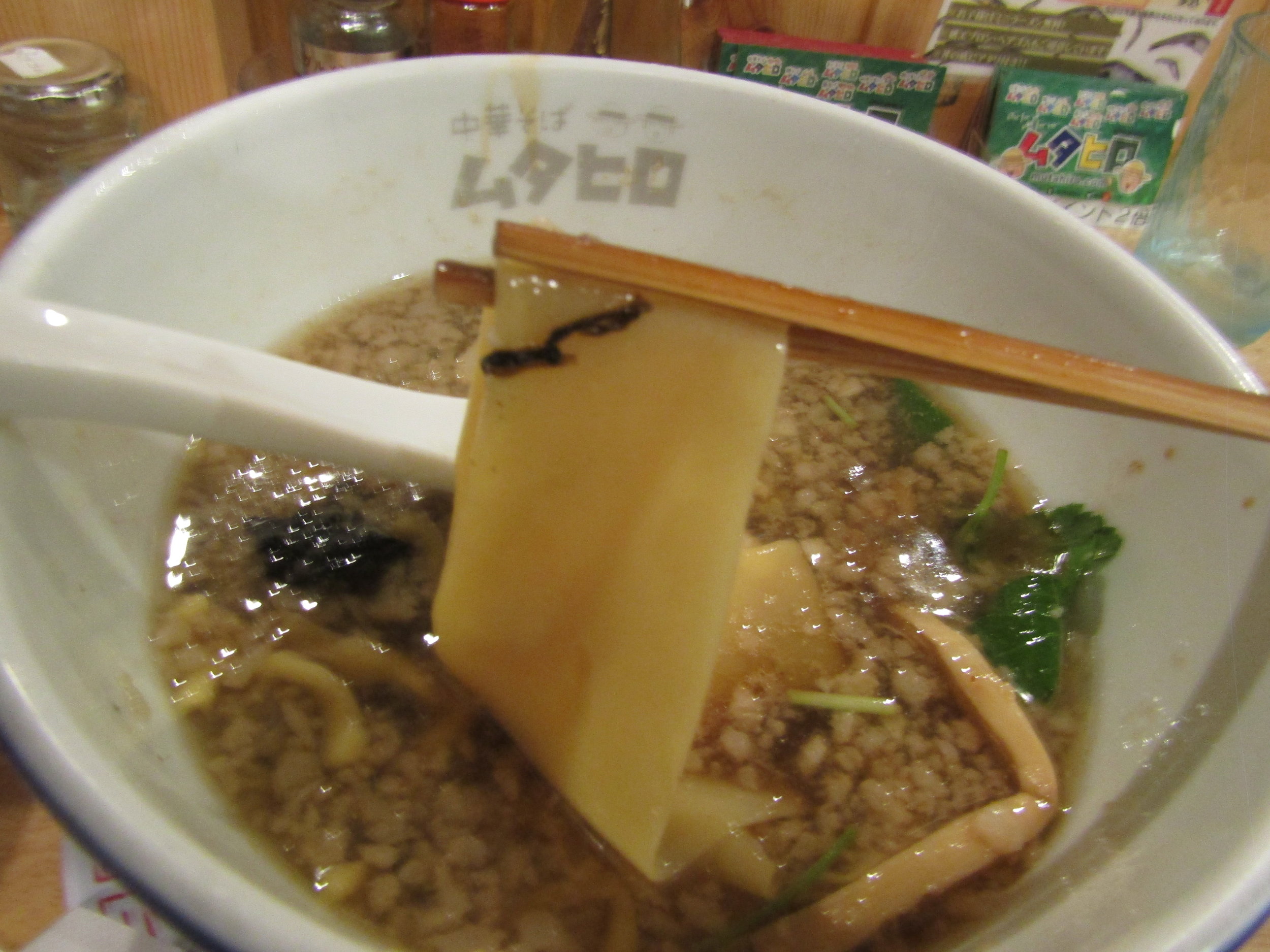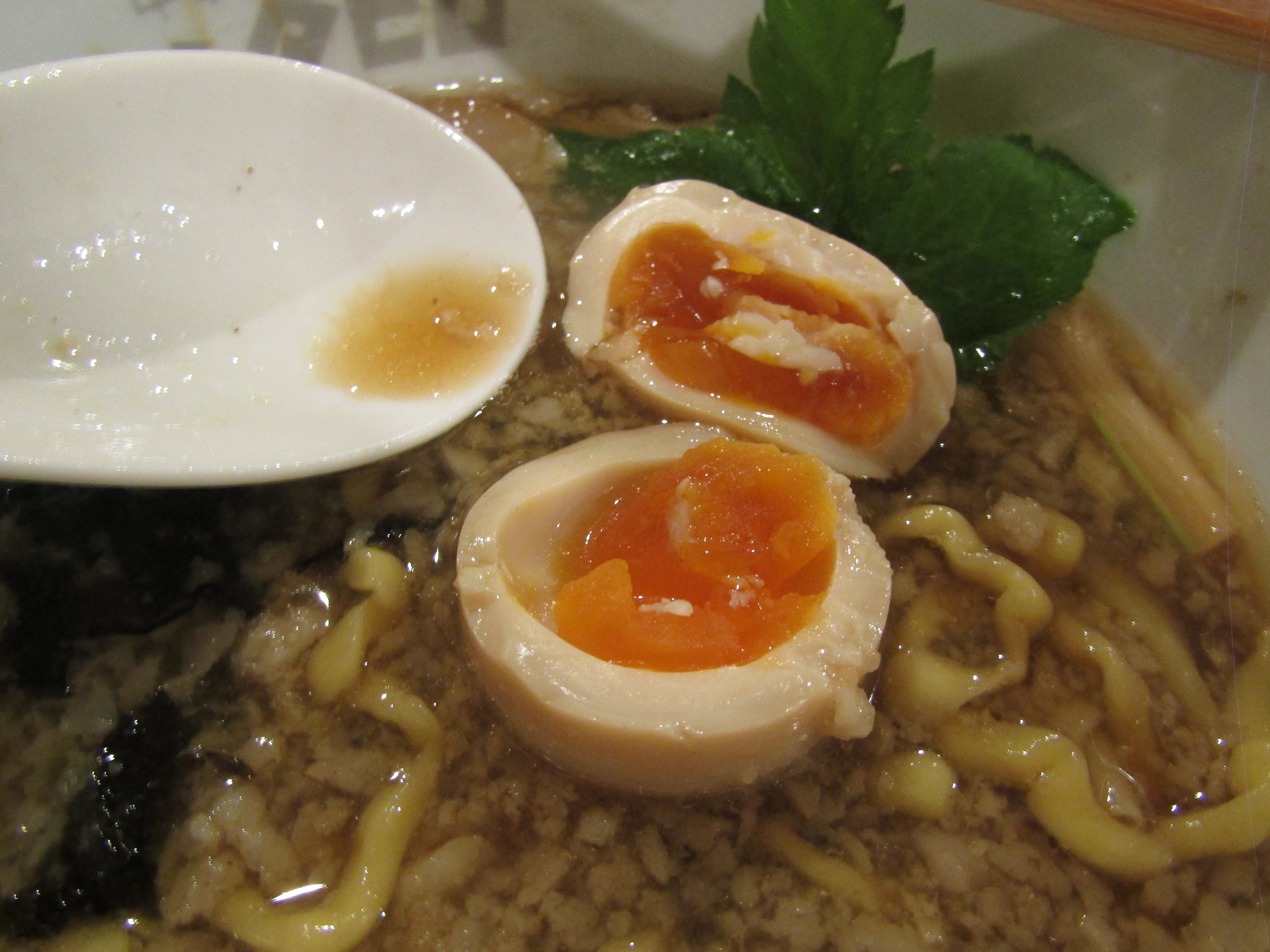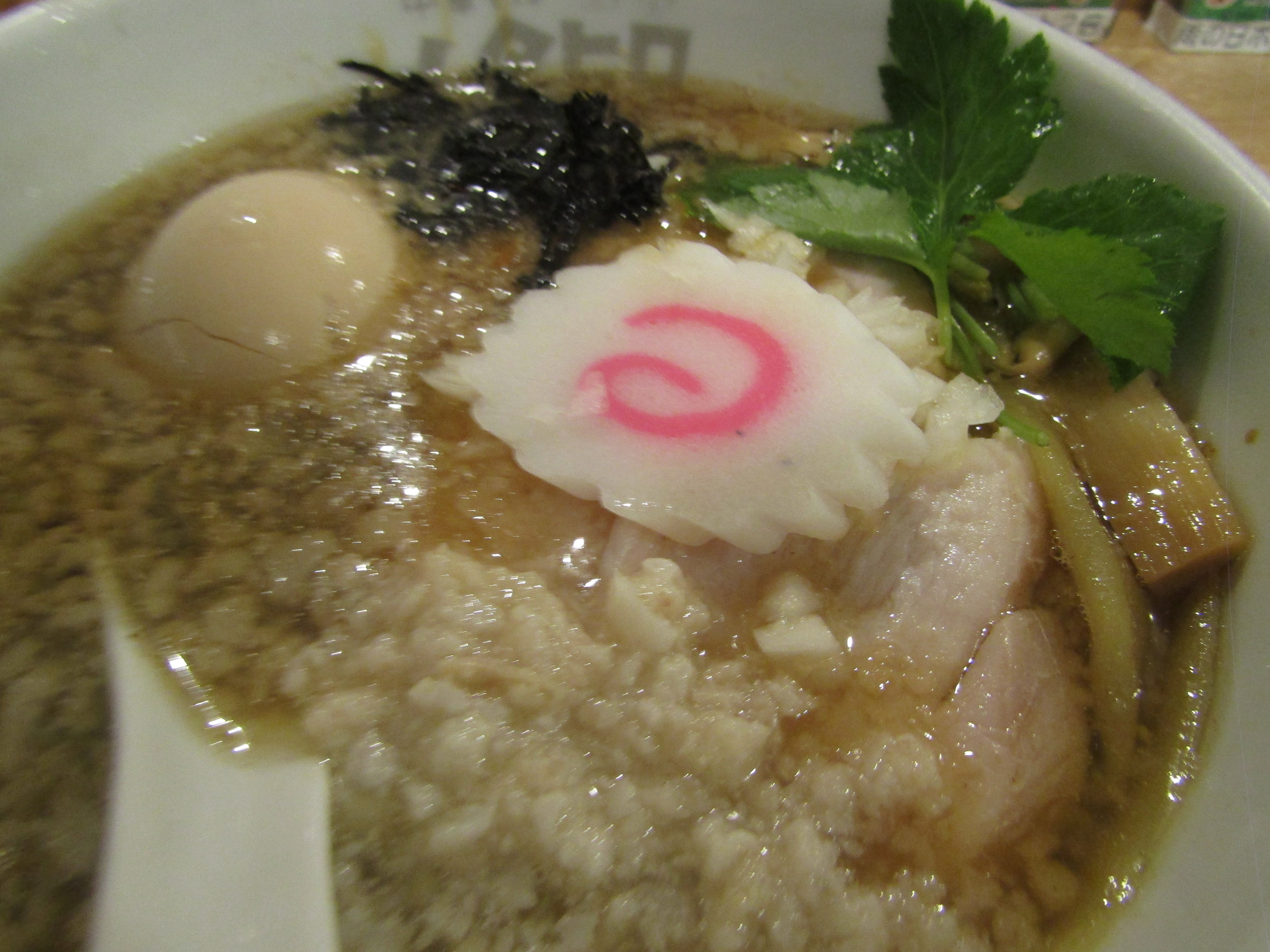Chuka Soba Mutahiro (中華そば ムタヒロ); Happy Smile Headquarters, Kokubunji
So I previously wrote about Tori Soba Mutahiro mentioning their growing franchise, but you may have noticed that it was their second brand/location. About a ten minute walk from Tori Soba Mutahiro is their honten, or their original location, Chuka Soba Mutahiro. The shop that birthed the now popular chicken ramen shop is this one featuring an amazing fatty, Niboshi ramen. Of all the brands that the Happy Smile company has created, the ramen here at Chuka Soba Mutahiro has to be the most unique. Located on the south side of Kokubunji station, check out what the home location has to offer. Mutahiro is also one of the few ramen shops in the top 100 on tabelog’s ranking that is open 365 days of the year. For lunch, they are open from 11:30-15:00 and 18:00-23:00 for dinner.
Chuka Soba Mutahiro serves up three different types of ramen using their specialty Niboshi based soup. On the first row in red is the Shoyu Niboshi Soba, second row in blue is the Shio (salt) Niboshi Soba, and the third row in yellow is their Niboshi Tsukemen. The first column has the Tokusei, or all topping version of each variety, second column is the Ajitama with soft boiled egg, third is regular ramen, and the fourth column has extra char siu. The green button from left to right are Oomori (extra noodles), extra topping of your choice, and diced onions. The blue button in that row is the chilled Niboshi soba. The white buttons from left to right is the gyoza (fried dumplings), char siu over rice, and regular bowl of rice. The pink buttons on the last row is beer, lemon sour (lemon flavored alcoholic drink), soft drink of your choice and the A&B buttons are the set menus. The set menus are listed outside during that day. The toppings available at Chuka Soba Mutahiro are eggs, extra char siu, long leek onions, and menma bamboo shoots. If you decide to purchase extra toppings, you’ll be asked at the counter which topping you would like to order. Same procedure with the soft drinks. Mutahiro offers coke, orange juice, and oolong tea which you choose at the counter. Once you have your tickets purchased, a staff member will direct you to your seat where you’ll hand the ticket over to the chef behind the counter.
On my visit I decided on the Ajitama Chuka Soba which came adorned with seaweed (not dried), Mitsuba (Japanese herb), Naruto (fish cake), menma bamboo shoots, diced onions, and a slice of pork char siu. As you can see from the photo, the ramen has a thick layer of pork fat floating at the surface. While the soup is primarily a Niboshi fish broth base, the base is combined with a pork back fat and chicken broth to round out the flavors. Due to the pork back fat at the surface, your mouth is initially coated with an incredibly flavorful oil, but is soon filled with the after taste of the Niboshi umami goodness. I really enjoyed this mixture of flavors as I haven’t had a bowl which utilized this combination before. In most cases Niboshi based ramen include either chicken or pork bone broth to balance the lightness of a fish based soup, but the addition of pork back fat gives it a really dense soup that is brimming with multitudes of flavor. The Shoyu tare really embraces the salty, savoriness of the broth making the ramen itself a nice compliment with a bowl of rice. The soup makes me want to pour it over a nice bowl of white rice and make a porridge out of it.
While rice may make for a good combination with the soup, the noodles do in fact make a nice carbohydrate pairing, with its egg-y, chewy texture. Mutahiro uses a a thick, egg noodle which counterbalance the heavy soup really well. As you can see from the photo, it is lined with kinks and has a curly texture which hold on to the pork back fat with every bite. The soup clings to the noodles very well and while it draw a lot of the fat and soup with every bite, due to its thickness and egg flavor, it has a flavor of its own that doesn’t get overpowered by the rich flavors of the niboshi and pork fat broth. Since the noodles are flavorful, it does make the bowl itself a bit overpowering, not allowing you to take breaks with the constant flavor explosions, so I do recommend grabbing a rice bowl on the side (which I did). Another thing I liked is the variety of noodles they use. So in addition to the egg noodle, Mutahiro also uses a flat long noodle as well. It is a different flour blend, and does not have as much of an egg flavor and tastes like a soft, won ton wrapper. I quite liked the change in texture it provided and the surprise I had when I found it mixed in to my bowl.
The egg was perfectly cooked, but if I were to order again, I may skip the egg. The bowl just has so many different flavor components that I didn’t really need an additional one with the egg. The naruto was a nostalgic touch that I wish more ramen shops would implement again. I’m not sure when ramen shops decided to move away from the naruto, fish cake topping, but I for one would love for a return. The mitsuba, a Japanese herb, helped cut through some of the fattiness of the soup, but it wasn’t enough to really make that big of a difference. What did help was the diced onions. The diced onions were fresh and crunchy, countering the fatty and thick soup and it really helped give it a refreshing flavor to help you finish the bowl. The char siu was the recently popular sous vide char siu which was nice as it wasn’t overly marinated and acted to add a protein without adding more flavor to the bowl. It was the first time I appreciated a ramen bowl having a meaty char siu as opposed to a fatty one as I may have clogged an artery if it was the latter in this bowl.
So as I mentioned earlier, I also ordered a rice bowl with my ramen. I was incredibly glad I did as it really helped finished my ramen as I needed a bit of the blandness of the rice. So I got the char siu over rice (which is why I didn’t get the Tokusei ramen with more char siu) which comes with a big spoonful of cubed pork over rice and seaweed. Seasoned long leek slices top the bowl giving it a nice crunchy consistency that balances with the fluffy, soft rice and the meaty char siu. The seaweed was nice giving the bowl a little flavor of the sea and an umami aspect. What I recommend with the bowl is to have the char siu and rice combination as is at first, but then pour some of the soup over the top with the second half. The rice and soup of the ramen make for an amazing porridge that is simply heartwarming.
Mutahiro has been open since 2011 and now has 12 locations including Ho Chi Minh, Vietnam and Seoul, South Korea. Hopefully I will be able to review every location, but for now I’ll keep up with their Japan locations and report back on the different varieties they serve up. What I like about this franchise is that they explore different flavor and ramen types. While serving up their traditional Chuka Soba here, Kinshicho and the Korea and Vietnam locations, they have a Chicken Ramen, Miso, Jiro-kei, and Maze-soba varieties at other locations in Japan. You can really tell they put their time and dedication before opening each franchise location and makes it exciting to try the different ones. Again, follow me over on facebook, twitter, and instagram and let me know if you end up visiting Mutahiro. Would love to hear your opinions on the ramen as well.







